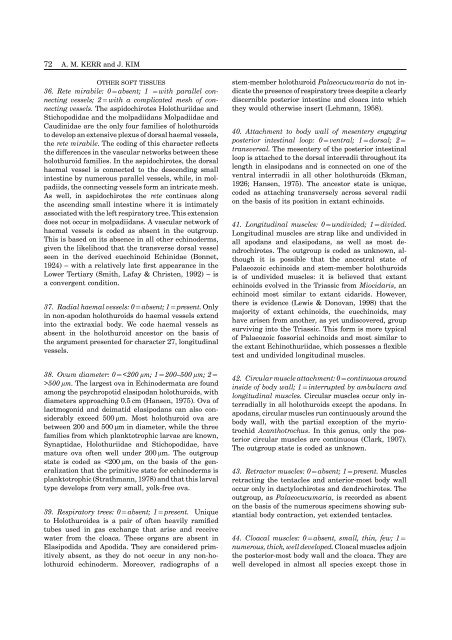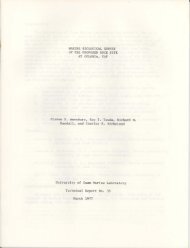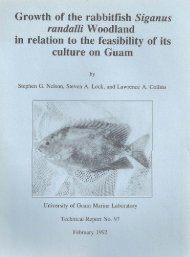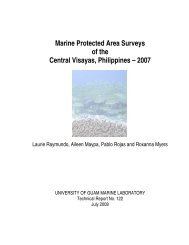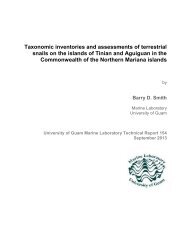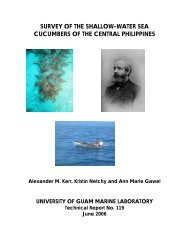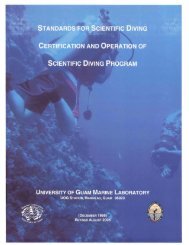Phylogeny of Holothuroidea (Echinodermata) inferred from ...
Phylogeny of Holothuroidea (Echinodermata) inferred from ...
Phylogeny of Holothuroidea (Echinodermata) inferred from ...
Create successful ePaper yourself
Turn your PDF publications into a flip-book with our unique Google optimized e-Paper software.
72 A. M. KERR and J. KIM<br />
OTHER SOFT TISSUES<br />
stem-member holothuroid Palaeocucumaria do not in-<br />
36. Rete mirabile: 0=absent; 1 =with parallel condiscernible<br />
posterior intestine and cloaca into which<br />
dicate the presence <strong>of</strong> respiratory trees despite a clearly<br />
necting vessels; 2=with a complicated mesh <strong>of</strong> conthey<br />
would otherwise insert (Lehmann, 1958).<br />
necting vessels. The aspidochirotes Holothuriidae and<br />
Stichopodidae and the molpadiidans Molpadiidae and<br />
Caudinidae are the only four families <strong>of</strong> holothuroids<br />
to develop an extensive plexus <strong>of</strong> dorsal haemal vessels,<br />
40. Attachment to body wall <strong>of</strong> mesentery engaging<br />
the rete mirabile. The coding <strong>of</strong> this character reflects<br />
posterior intestinal loop: 0=ventral; 1=dorsal; 2=<br />
the differences in the vascular networks between these<br />
transversal. The mesentery <strong>of</strong> the posterior intestinal<br />
holothuroid families. In the aspidochirotes, the dorsal<br />
loop is attached to the dorsal interradii throughout its<br />
haemal vessel is connected to the descending small<br />
length in elasipodans and is connected on one <strong>of</strong> the<br />
intestine by numerous parallel vessels, while, in molventral<br />
interradii in all other holothuroids (Ekman,<br />
padiids, the connecting vessels form an intricate mesh.<br />
1926; Hansen, 1975). The ancestor state is unique,<br />
As well, in aspidochirotes the rete continues along<br />
coded as attaching transversely across several radii<br />
the ascending small intestine where it is intimately<br />
on the basis <strong>of</strong> its position in extant echinoids.<br />
associated with the left respiratory tree. This extension<br />
does not occur in molpadiidans. A vascular network <strong>of</strong> 41. Longitudinal muscles: 0=undivided; 1=divided.<br />
haemal vessels is coded as absent in the outgroup. Longitudinal muscles are strap like and undivided in<br />
This is based on its absence in all other echinoderms, all apodans and elasipodans, as well as most degiven<br />
the likelihood that the transverse dorsal vessel ndrochirotes. The outgroup is coded as unknown, alseen<br />
in the derived euechinoid Echinidae (Bonnet, though it is possible that the ancestral state <strong>of</strong><br />
1924) – with a relatively late first appearance in the Palaeozoic echinoids and stem-member holothuroids<br />
Lower Tertiary (Smith, Lafay & Christen, 1992) – is is <strong>of</strong> undivided muscles: it is believed that extant<br />
a convergent condition.<br />
echinoids evolved in the Triassic <strong>from</strong> Miocidaris, an<br />
echinoid most similar to extant cidarids. However,<br />
there is evidence (Lewis & Donovan, 1998) that the<br />
37. Radial haemal vessels: 0=absent; 1=present. Only<br />
majority <strong>of</strong> extant echinoids, the euechinoids, may<br />
in non-apodan holothuroids do haemal vessels extend<br />
have arisen <strong>from</strong> another, as yet undiscovered, group<br />
into the extraxial body. We code haemal vessels as<br />
surviving into the Triassic. This form is more typical<br />
absent in the holothuroid ancestor on the basis <strong>of</strong><br />
<strong>of</strong> Palaeozoic fossorial echinoids and most similar to<br />
the argument presented for character 27, longitudinal<br />
the extant Echinothuriidae, which possesses a flexible<br />
vessels.<br />
test and undivided longitudinal muscles.<br />
38. Ovum diameter: 0=500 μm. The largest ova in <strong>Echinodermata</strong> are found<br />
inside <strong>of</strong> body wall; 1=interrupted by ambulacra and<br />
among the psychropotid elasipodan holothuroids, with<br />
longitudinal muscles. Circular muscles occur only indiameters<br />
approaching 0.5 cm (Hansen, 1975). Ova <strong>of</strong><br />
terradially in all holothuroids except the apodans. In<br />
laetmogonid and deimatid elasipodans can also conapodans,<br />
circular muscles run continuously around the<br />
siderably exceed 500 μm. Most holothuroid ova are<br />
body wall, with the partial exception <strong>of</strong> the myriobetween<br />
200 and 500 μm in diameter, while the three<br />
trochid Acanthotrochus. In this genus, only the posfamilies<br />
<strong>from</strong> which planktotrophic larvae are known,<br />
terior circular muscles are continuous (Clark, 1907).<br />
Synaptidae, Holothuriidae and Stichopodidae, have<br />
The outgroup state is coded as unknown.<br />
mature ova <strong>of</strong>ten well under 200 μm. The outgroup<br />
state is coded as


